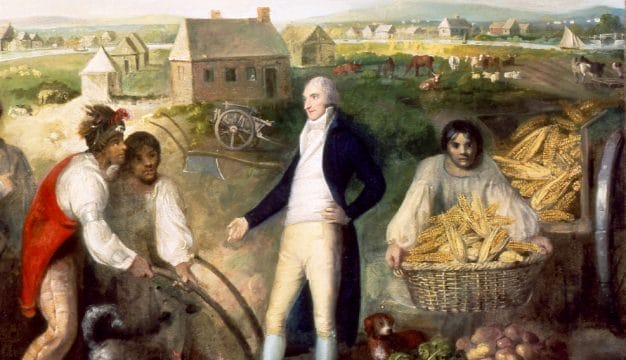Macon County
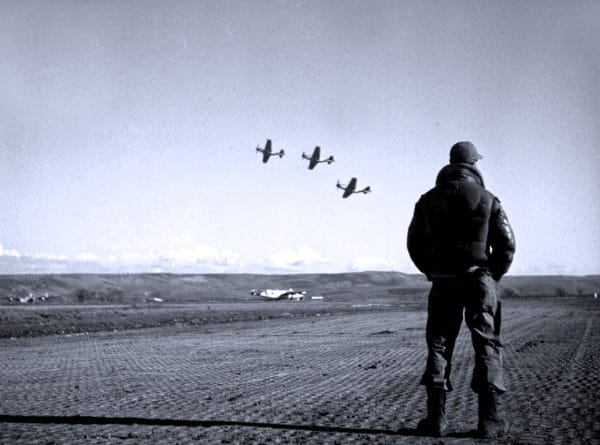 Tuskegee Airmen in Flight
Located in the east-central part of the state, Macon County is home to famed Tuskegee University, founded in 1881 by Booker T. Washington as Tuskegee Normal School. The county was home to innovative researcher George Washington Carver, who taught at Tuskegee for decades, and civil-rights pioneer Rosa Parks was born in Tuskegee in 1913. During World War II Tuskegee was home to the Tuskegee Airmen, the first squadron of African American pilots in the U.S. military. The county was also the location of the infamous Tuskegee Syphilis Study. Macon County is governed by an elected five-member county commission and includes three incorporated communities, Notasulga, Shorter, and Tuskegee.
Tuskegee Airmen in Flight
Located in the east-central part of the state, Macon County is home to famed Tuskegee University, founded in 1881 by Booker T. Washington as Tuskegee Normal School. The county was home to innovative researcher George Washington Carver, who taught at Tuskegee for decades, and civil-rights pioneer Rosa Parks was born in Tuskegee in 1913. During World War II Tuskegee was home to the Tuskegee Airmen, the first squadron of African American pilots in the U.S. military. The county was also the location of the infamous Tuskegee Syphilis Study. Macon County is governed by an elected five-member county commission and includes three incorporated communities, Notasulga, Shorter, and Tuskegee.
- Founding Date: December 18, 1832
- Area: 614 square miles
- Population: 19,532 (2020 Census estimate)
- Major Waterways: Tallapoosa River
- Major Highways: Interstate 85, U.S. 29, U.S. 80
- County Seat: Tuskegee
- Largest City: Tuskegee
History
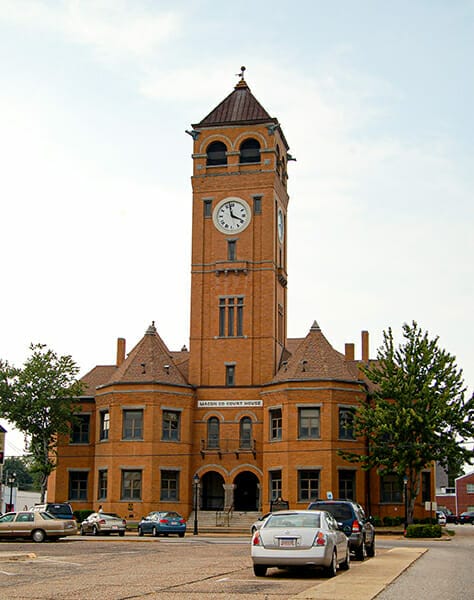 Macon County Courthouse
Macon County was established by an act of the Alabama legislature on December 18, 1832, although the county did not exhibit its final and present-day boundaries until 1866. The county was created from territory acquired from the last cession of the Creek Indians on March 24, 1832, in the Treaty of Cusseta. Macon County is named for Nathaniel Macon, a distinguished soldier and U.S. senator from North Carolina. Most of Macon’s earliest settlers came from Tennessee, Kentucky, Virginia, and the Carolinas via the Old Federal Road, which connected Washington, D.C., to New Orleans. Some of the earliest towns and settlements in Macon County were Tuskegee, Shorter, Franklin, and Notasulga. Tuskegee became Macon County’s first and only county seat in 1832. The original courthouses were simple log and wooden structures. In the mid-nineteenth century, the county erected a brick structure in the Revival and Romanesque styles complete with gargoyles. It continues to serve as the county court house today and was listed on the National Register of Historic Places in 1978.
Macon County Courthouse
Macon County was established by an act of the Alabama legislature on December 18, 1832, although the county did not exhibit its final and present-day boundaries until 1866. The county was created from territory acquired from the last cession of the Creek Indians on March 24, 1832, in the Treaty of Cusseta. Macon County is named for Nathaniel Macon, a distinguished soldier and U.S. senator from North Carolina. Most of Macon’s earliest settlers came from Tennessee, Kentucky, Virginia, and the Carolinas via the Old Federal Road, which connected Washington, D.C., to New Orleans. Some of the earliest towns and settlements in Macon County were Tuskegee, Shorter, Franklin, and Notasulga. Tuskegee became Macon County’s first and only county seat in 1832. The original courthouses were simple log and wooden structures. In the mid-nineteenth century, the county erected a brick structure in the Revival and Romanesque styles complete with gargoyles. It continues to serve as the county court house today and was listed on the National Register of Historic Places in 1978.
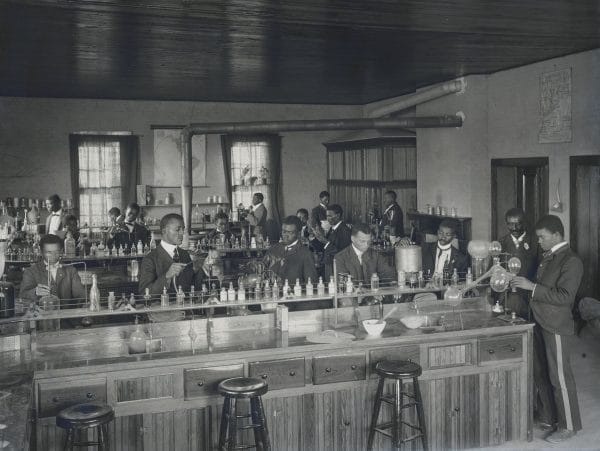 George Washington Carver with Students
By the late nineteenth century, Macon County was an important center of African American education. Booker T. Washington established the Tuskegee Normal School in 1881 to train African American teachers. Later known as the Tuskegee Institute and then Tuskegee University, the school employed one of America’s most innovative researchers in the field of agriculture, George Washington Carver, as well as a number of other pioneering African American researchers and educators. During World War II, Macon County was the site of the Army Air Force’s segregated flight training program, which gave African American men their first opportunity to serve as military aviators. Known today as the Tuskegee Airmen, almost 1,000 men earned their wings at Tuskegee Army Air Field. Tuskegee also served as an important site of rallies and protests during the civil rights movement. In 1957, state senator, white supremacist, and county resident Samuel M. Engelhardt pushed through legislation that redrew Tuskegee city boundaries to exclude most of the city’s African American voters to preserve white dominance. African American residents responded to the racially motivated gerrymandering by boycotting white-owned businesses for more than three years, prompting bankruptcies and closures. In response, Engelhardt sponsored legislation that would have dissolved Macon County into neighboring counties, but it was not enacted. In 1960, the U.S. Supreme Court ruled in Gomillion v. Lightfoot that the city borders violated the Fifteenth Amendment by denying black residents the right to vote and the boundaries were revised in 1961. Macon County and Tuskegee were the headquarters for one of the most notorious events in American history, the Tuskegee Syphilis Study. From 1932 to 1972, the U.S. Public Health Service, Tuskegee Institute, and state, county, and city health agencies misled African American males infected with syphilis into a treatment program, while in fact withholding treatment, to study the effects of long-term syphilis infection on the human body.
George Washington Carver with Students
By the late nineteenth century, Macon County was an important center of African American education. Booker T. Washington established the Tuskegee Normal School in 1881 to train African American teachers. Later known as the Tuskegee Institute and then Tuskegee University, the school employed one of America’s most innovative researchers in the field of agriculture, George Washington Carver, as well as a number of other pioneering African American researchers and educators. During World War II, Macon County was the site of the Army Air Force’s segregated flight training program, which gave African American men their first opportunity to serve as military aviators. Known today as the Tuskegee Airmen, almost 1,000 men earned their wings at Tuskegee Army Air Field. Tuskegee also served as an important site of rallies and protests during the civil rights movement. In 1957, state senator, white supremacist, and county resident Samuel M. Engelhardt pushed through legislation that redrew Tuskegee city boundaries to exclude most of the city’s African American voters to preserve white dominance. African American residents responded to the racially motivated gerrymandering by boycotting white-owned businesses for more than three years, prompting bankruptcies and closures. In response, Engelhardt sponsored legislation that would have dissolved Macon County into neighboring counties, but it was not enacted. In 1960, the U.S. Supreme Court ruled in Gomillion v. Lightfoot that the city borders violated the Fifteenth Amendment by denying black residents the right to vote and the boundaries were revised in 1961. Macon County and Tuskegee were the headquarters for one of the most notorious events in American history, the Tuskegee Syphilis Study. From 1932 to 1972, the U.S. Public Health Service, Tuskegee Institute, and state, county, and city health agencies misled African American males infected with syphilis into a treatment program, while in fact withholding treatment, to study the effects of long-term syphilis infection on the human body.
Major Cities and Demographics
According to 2020 Census estimates, the population of Macon County was 19,532. Of that total, 79.9 percent of respondents identified themselves as African American, 18.0 percent as white, 2.1 percent as Hispanic, 1.3 percent as two or more races, 0.5 percent as Asian, and 0.3 percent as Native American. The county seat Tuskegee is Macon County’s largest city with an estimated population of 9,395. Other significant population centers are Notasulga and Shorter. The median household income was $35,450, compared with $52,035 for the state as a whole, and the per capita income was $22,170, compared with $28,934 for the state as a whole.
Economy
 Organic Farm in Shorter
As part of Alabama’s Black Belt, Macon County remained largely agricultural until well into the twentieth century. Cotton was the county’s main crop until the 1930s and 1940s, when farmers diversified into corn, hay, peanuts, potatoes, and soybeans as well as livestock and poultry. Although Macon County has moved somewhat from an agriculture-based economy to an industry-based economy over the last half of the twentieth century, it has done so slowly and with limited success. The county remains largely rural and poor. Government and education provide much of the employment for Macon County.
Organic Farm in Shorter
As part of Alabama’s Black Belt, Macon County remained largely agricultural until well into the twentieth century. Cotton was the county’s main crop until the 1930s and 1940s, when farmers diversified into corn, hay, peanuts, potatoes, and soybeans as well as livestock and poultry. Although Macon County has moved somewhat from an agriculture-based economy to an industry-based economy over the last half of the twentieth century, it has done so slowly and with limited success. The county remains largely rural and poor. Government and education provide much of the employment for Macon County.
Employment
According to 2020 Census estimates, the workforce in Macon County was divided among the following industrial categories:
- Educational services, and health care and social assistance (30.6 percent)
- Manufacturing (13.1 percent)
- Arts, entertainment, recreation, and accommodation and food services (12.1 percent)
- Professional, scientific, management, and administrative and waste management services (9.3 percent)
- Retail trade (8.9 percent)
- Transportation and warehousing, and utilities (8.9 percent)
- Public administration (6.0 percent)
- Other services, except public administration (4.7 percent)
- Finance and insurance, and real estate, rental, and leasing (3.6 percent)
- Construction (2.9 percent)
- Agriculture, forestry, fishing and hunting, and extractive (2.0 percent)
- Wholesale trade (0.5 percent)
- Information (0.2 percent)
Education
The Macon County school system oversees seven primary and secondary schools. Located in the city of Tuskegee, Tuskegee University is a historically black institution founded in 1881 by Booker T. Washington as a training school for black teachers. Tuskegee University attained university status in 1985 and has since offered both undergraduate and graduate degrees in a variety of disciplines.
Geography
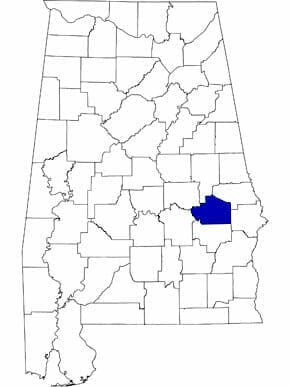 Macon County Map
Encompassing 614 square miles, Macon County is part of the Coastal Plain physiographic section and consists of rolling prairies and flat plains. Shortleaf pine forests dot the county’s landscape, which is covered with the dark, loamy soil of the Black Belt. Macon County is bordered by Elmore and Montgomery Counties to the west, Tallapoosa and Lee Counties to the north, Russell County to the west, and Bullock County to the south.
Macon County Map
Encompassing 614 square miles, Macon County is part of the Coastal Plain physiographic section and consists of rolling prairies and flat plains. Shortleaf pine forests dot the county’s landscape, which is covered with the dark, loamy soil of the Black Belt. Macon County is bordered by Elmore and Montgomery Counties to the west, Tallapoosa and Lee Counties to the north, Russell County to the west, and Bullock County to the south.
The Tallapoosa River and its lower tributaries run throughout Macon County and are home to 120 species of fish and 31 species of mussel. The Tuskegee National Forest consists of 11,000 acres of former farmland that was reforested and redeveloped for recreational use in the 1930s.
Several main transportation routes run through Macon County. Interstate 85 runs northeast-southwest through the northern half of the county. U.S. Highway 29 runs north-south through the middle of Macon County, and U.S. Highway 80 runs east-west through the middle of the county. The Tuskegee Municipal Airport is Macon County’s only airport.
Events and Places of Interest
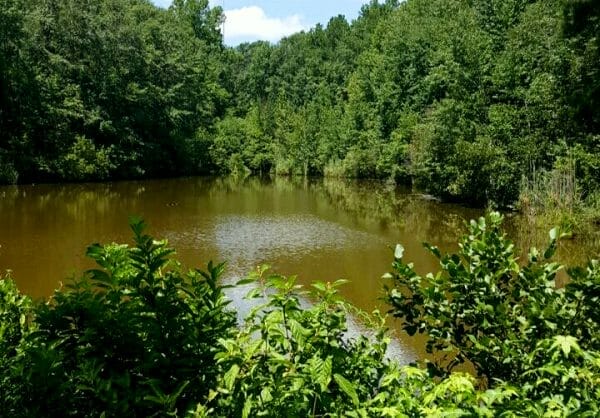 Tuskegee National Forest
There are a number of recreational opportunities for visitors to Macon County. The Tuskegee National Forest, the smallest national forest in the nation, affords visitors opportunities for camping, picnicking, hunting, and horseback riding. The park also includes eight and one-half miles of the Bartram Trail; the first trail in Alabama designated a National Recreation Trail, as well as a number of other hiking trails. A replica of Booker T. Washington’s log cabin birthplace is located in the forest and is open to visitors. Lake Tuskegee, a city-owned recreational area, offers playgrounds, picnic areas, and nearly 92 acres of water for fishing, sailing, and other water sports.
Tuskegee National Forest
There are a number of recreational opportunities for visitors to Macon County. The Tuskegee National Forest, the smallest national forest in the nation, affords visitors opportunities for camping, picnicking, hunting, and horseback riding. The park also includes eight and one-half miles of the Bartram Trail; the first trail in Alabama designated a National Recreation Trail, as well as a number of other hiking trails. A replica of Booker T. Washington’s log cabin birthplace is located in the forest and is open to visitors. Lake Tuskegee, a city-owned recreational area, offers playgrounds, picnic areas, and nearly 92 acres of water for fishing, sailing, and other water sports.
 School on Wheels
Macon County is rich in history and culture. The Tuskegee Institute National Historic Site, located on the Tuskegee University campus, became a part of the national park system in 1974. The site honors men such as Booker T. Washington and George Washington Carver, who helped lead the Tuskegee Normal School to its present world-renowned status. The institute is home to the George Washington Carver Museum and The Oaks, home of Booker T. Washington. Each May, the institute hosts the Annual George Washington Carver Arts and Crafts festival, a day-long festival that celebrates artistic expression through music, dance, paintings, sculpture, crafts, and vendors.
School on Wheels
Macon County is rich in history and culture. The Tuskegee Institute National Historic Site, located on the Tuskegee University campus, became a part of the national park system in 1974. The site honors men such as Booker T. Washington and George Washington Carver, who helped lead the Tuskegee Normal School to its present world-renowned status. The institute is home to the George Washington Carver Museum and The Oaks, home of Booker T. Washington. Each May, the institute hosts the Annual George Washington Carver Arts and Crafts festival, a day-long festival that celebrates artistic expression through music, dance, paintings, sculpture, crafts, and vendors.
Visitors to Tuskegee University can tour the historic campus, which is designated an official historic district, and view buildings that were constructed by Tuskegee Institute students and designed by Robert R. Taylor, the first African American graduate of the Massachusetts Institute of Technology. Although the original university chapel burned down in 1957, visitors can visit the new chapel, completed in 1969, to see a reproduction of the stained-glass windows that hung in the first chapel. The windows are known as the “Singing Windows” and depict 11 African American spirituals. The historic Tuskegee Cemetery, where Booker T. Washington is buried, sits next to the chapel, and a memorial to Washington sits near the center of campus.
 Moton Field
In the 1940s, Tuskegee became the training place for America’s first African American military pilots. The training program became known as the Tuskegee Experience and the pilots and crews as the Tuskegee Airmen. The Tuskegee Airmen National Historic Site preserves the memory of this program and its participants through a series of exhibits and presentations. The Tuskegee History Center is another popular cultural site in Tuskegee and houses exhibits featuring photos and videos of the infamous Tuskegee Syphilis Study as well as other collections related to regional history and cultures. Forty historic walking and driving tours pay tribute to the many men and women who have made Tuskegee home, including Native Americans, European Americans, and African Americans.
Moton Field
In the 1940s, Tuskegee became the training place for America’s first African American military pilots. The training program became known as the Tuskegee Experience and the pilots and crews as the Tuskegee Airmen. The Tuskegee Airmen National Historic Site preserves the memory of this program and its participants through a series of exhibits and presentations. The Tuskegee History Center is another popular cultural site in Tuskegee and houses exhibits featuring photos and videos of the infamous Tuskegee Syphilis Study as well as other collections related to regional history and cultures. Forty historic walking and driving tours pay tribute to the many men and women who have made Tuskegee home, including Native Americans, European Americans, and African Americans.
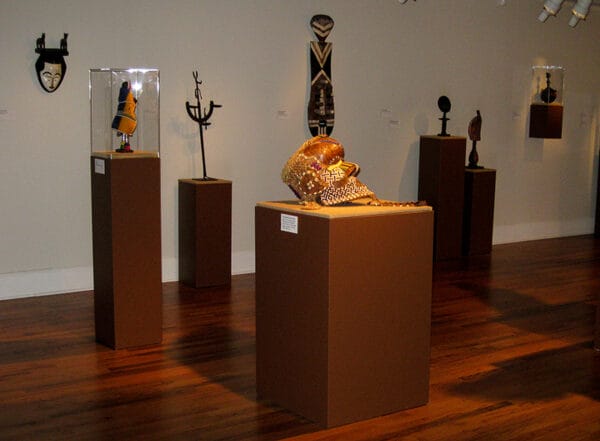 Lovette W. Harper Collection of African Art
The Tuskegee Heritage Museum exhibits artifacts relating to the Creek Indians as well as memorabilia about Booker T. Washington, George Washington Carver, and the Tuskegee Airmen. The Legacy Museum, located on the campus of Tuskegee University, was established in 2009 to honor the memory of the participants in the Tuskegee Syphilis Study and features exhibits related to the study as well as a notable collection of African art. Built in 1906 by the United Daughters of the Confederacy, the Tuskegee Confederate Monument honors Macon County soldiers who fought for the Confederacy in the Civil War. The monument was an important rally and protest site during the civil-rights movement in the 1960s. In addition, the Tuskegee Repertory Theatre produces original plays that reflect African American cultural heritage, especially the legacy of historic Tuskegee.
Lovette W. Harper Collection of African Art
The Tuskegee Heritage Museum exhibits artifacts relating to the Creek Indians as well as memorabilia about Booker T. Washington, George Washington Carver, and the Tuskegee Airmen. The Legacy Museum, located on the campus of Tuskegee University, was established in 2009 to honor the memory of the participants in the Tuskegee Syphilis Study and features exhibits related to the study as well as a notable collection of African art. Built in 1906 by the United Daughters of the Confederacy, the Tuskegee Confederate Monument honors Macon County soldiers who fought for the Confederacy in the Civil War. The monument was an important rally and protest site during the civil-rights movement in the 1960s. In addition, the Tuskegee Repertory Theatre produces original plays that reflect African American cultural heritage, especially the legacy of historic Tuskegee.
Further Reading
- The Heritage of Macon County, Alabama. Clanton, Ala.: Heritage Publishing Consultants, 2003.
- Yamaguchi, Elizabeth Hughes. “Macon County, Alabama: Its Land and Its People, From Pre-History to 1870.” M.A. thesis. Auburn University, 1981.
External Links
- Macon County
- Macon County Schools
- City of Tuskegee
- Town of Notasulga
- Town of Shorter
- Tuskegee Area Chamber of Commerce
- National Register of Historic Places: Macon County
- Tuskegee University
- Tuskegee Repertory Theatre
- Tuskegee Institute National Historic Site
- Legacy Museum
- Tuskegee History Center
- Tuskegee Airmen National Historic Site
- Tuskegee National Forest



